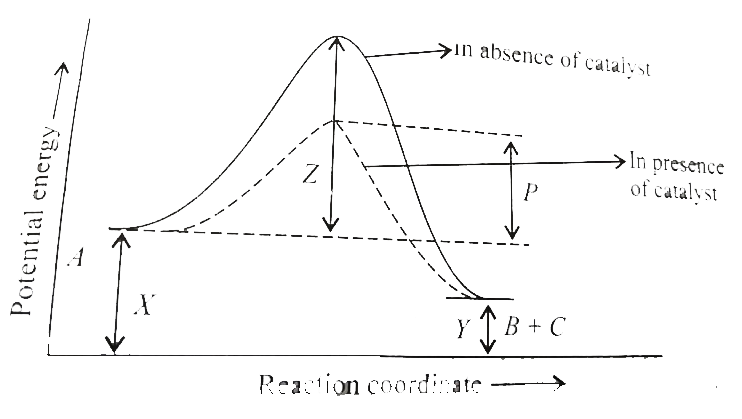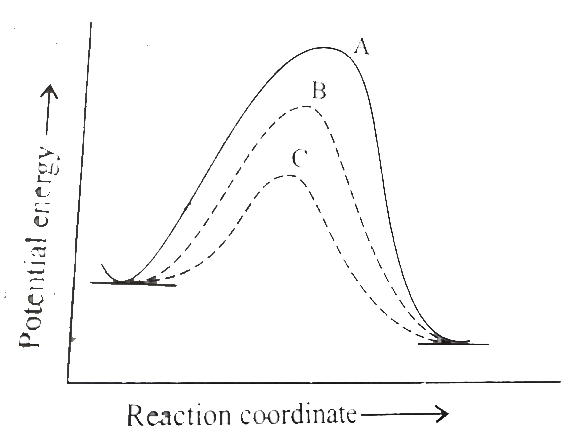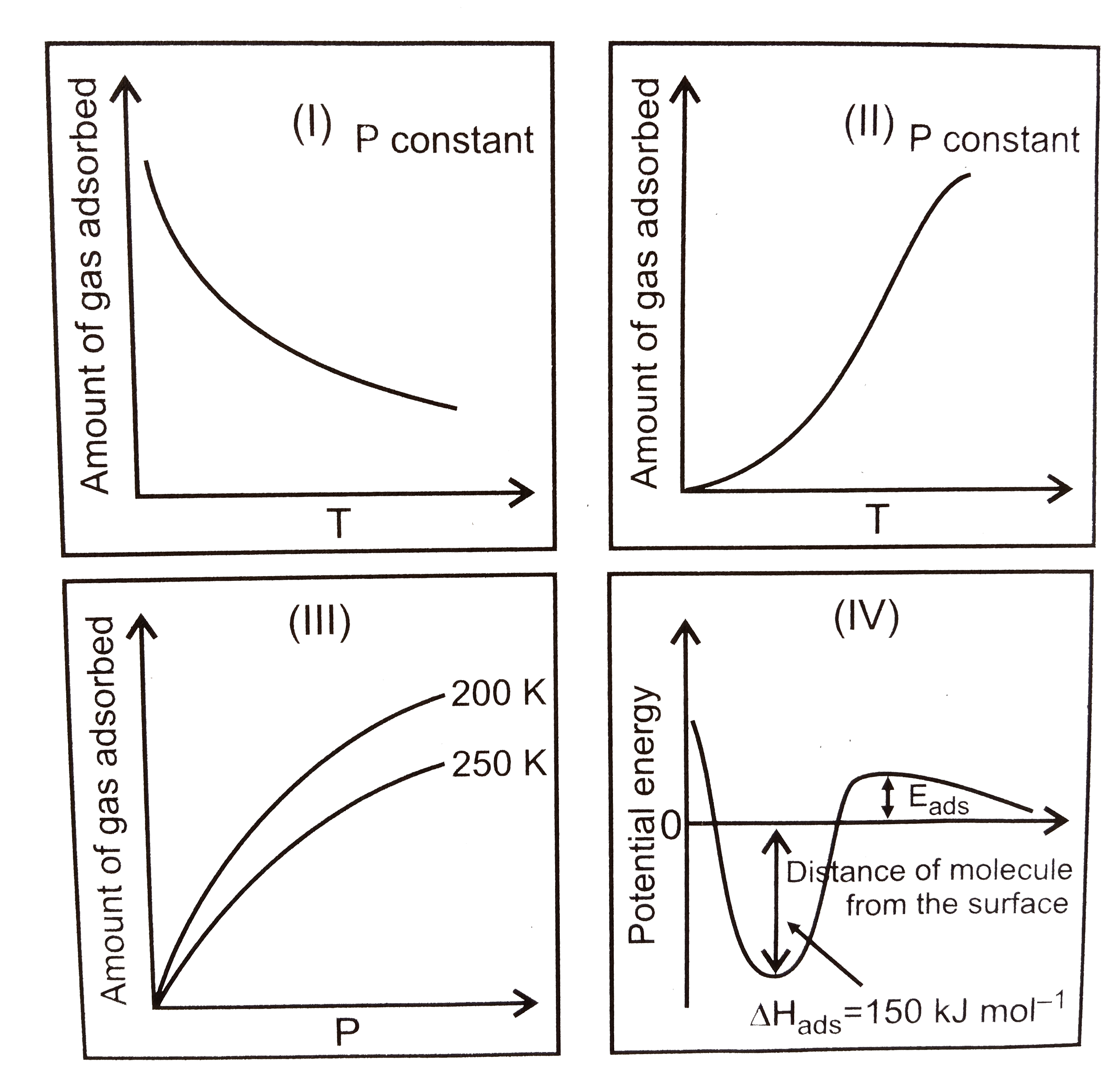Exercises Interger from CENGAGE CHEMISTRY (HINGLISH) SURFACE CHEMISTRY for Class 12
| Class 12 | CHEMISTRY |
| Chapter | SURFACE CHEMISTRY |
| CENGAGE CHEMISTRY (HINGLISH) | Exercises Interger |
| Medium | English |
| Academic Year | 2023-2024 |
Question 33
Collidal solution is a heterogeneous solution which contains particle of intermediate size, i.e., (diameter between 1 and 1000 nm) colloidal is not a substance but it is a state of a substance which depends upon the molecular size. Colloidal solutions are intermediate between ture solution and suspensions.
The size of the colloidal particles lies in the range View SolutionQuestion 34
Collidal solution is a heterogeneous solution which contains particle of intermediate size, i.e., (diameter between 1 and 1000 nm) colloidal is not a substance but it is a state of a substance which depends upon the molecular size. Colloidal solutions are intermediate between ture solution and suspensions.
The colloidal solution of a solid as the disperesed ohases and a gas as the dispersed medium is called View SolutionQuestion 35
Collidal solution is a heterogeneous solution which contains particle of intermediate size, i.e., (diameter between 1 and 1000 nm) colloidal is not a substance but it is a state of a substance which depends upon the molecular size. Colloidal solutions are intermediate between ture solution and suspensions.
The colloidal particle can pass through View SolutionQuestion 36
Collidal solution is a heterogeneous solution which contains particle of intermediate size, i.e., (diameter between 1 and 1000 nm) colloidal is not a substance but it is a state of a substance which depends upon the molecular size. Colloidal solutions are intermediate between ture solution and suspensions.
The difference between a lyophilic and lyophobic colloid is their View SolutionQuestion 37
Collidal solution is a heterogeneous solution which contains particle of intermediate size, i.e., (diameter between 1 and 1000 nm) colloidal is not a substance but it is a state of a substance which depends upon the molecular size. Colloidal solutions are intermediate between ture solution and suspensions.
Chemisorption View SolutionQuestion 38
A chemist studied the phenomenon of adsorption by putting blood charcoal in KCL solution. He observed difference in the behaviour with dilute KCL solution and with concentrated KCL solution. He also studied the adsorption of different gases on solid adsorbent and the effect of temperature on adsorption. He put forward a mathematical relationship relating x/m with equilibrium pressure.
Which of the following is correct ? View SolutionQuestion 39
A chemist studied the phenomenon of adsorption by putting blood charcoal in KCL solution. He observed difference in the behaviour with dilute KCL solution and with concentrated KCL solution. He also studied the adsorption of different gases on solid adsorbent and the effect of temperature on adsorption. He put forward a mathematical relationship relating x/m with equilibrium pressure.
Which of the following plot will be liner? (More than one correct)View SolutionQuestion 40
A chemist studied the phenomenon of adsorption by putting blood charcoal in KCL solution. He observed difference in the behaviour with dilute KCL solution and with concentrated KCL solution. He also studied the adsorption of different gases on solid adsorbent and the effect of temperature on adsorption. He put forward a mathematical relationship relating x/m with equilibrium pressure.
The correct order of the adsorption of gases will be View SolutionQuestion 41
A chemist studied the phenomenon of adsorption by putting blood charcoal in KCL solution. He observed difference in the behaviour with dilute KCL solution and with concentrated KCL solution. He also studied the adsorption of different gases on solid adsorbent and the effect of temperature on adsorption. He put forward a mathematical relationship relating x/m with equilibrium pressure.
Which of the following result is oberved with the experiment of KCl solution ? View SolutionQuestion 42
Collidal dispersion have been classified into different types depending upon the physical state of the dispersed phases and the dispersion medium. They are prepared in the industry or in the laboratory by a number of methods and then purified. The protective action of lyophilic colloids was studied by Zsigmondy and he introduced a term called gold number.
Which of the following does not form a lyophilic colloid?View SolutionQuestion 43
Collidal dispersion have been classified into different types depending upon the physical state of the dispersed phases and the dispersion medium. They are prepared in the industry or in the laboratory by a number of methods and then purified. The protective action of lyophilic colloids was studied by Zsigmondy and he introduced a term called gold number.
In the experiment on electro-osmosis in which of the following the level of the dispersion medium will fall on the cathode side. View SolutionQuestion 44
Collidal dispersion have been classified into different types depending upon the physical state of the dispersed phases and the dispersion medium. They are prepared in the industry or in the laboratory by a number of methods and then purified. The protective action of lyophilic colloids was studied by Zsigmondy and he introduced a term called gold number.
Criticle micelle concentration (CMC) of saop solution lies in the range. View SolutionQuestion 45
Collidal dispersion have been classified into different types depending upon the physical state of the dispersed phases and the dispersion medium. They are prepared in the industry or in the laboratory by a number of methods and then purified. The protective action of lyophilic colloids was studied by Zsigmondy and he introduced a term called gold number.
Which of the following will have maximum flocculation value for aresnic sulphide sol? View SolutionQuestion 46
Collidal dispersion have been classified into different types depending upon the physical state of the dispersed phases and the dispersion medium. They are prepared in the industry or in the laboratory by a number of methods and then purified. The protective action of lyophilic colloids was studied by Zsigmondy and he introduced a term called gold number.
Which of the following has minimum gold number? View SolutionQuestion 47
Adsorption is the tendency of accumulation of molecular species at the surface of solid or liquid. Depending upon the nature of bonds or forces of attraction between adsorbate and adsorbent. It is classofied between physisorption and chemisorption.
Which of the following statements are correct? (More than one correct) View SolutionQuestion 48
Adsorption is the tendency of accumulation of molecular species at the surface of solid or liquid. Depending upon the nature of bonds or forces of attraction between adsorbate and adsorbent. It is classofied between physisorption and chemisorption.
Which of the following gas molecules have maximum value enthalpy of physisorption? View SolutionQuestion 49
Adsorption is the tendency of accumulation of molecular species at the surface of solid or liquid. Depending upon the nature of bonds or forces of attraction between adsorbate and adsorbent. It is classofied between physisorption and chemisorption.
Which of the following gases is adsorbed most by activated charcoal? View SolutionQuestion 50
Adsorption is the tendency of accumulation of molecular species at the surface of solid or liquid. Depending upon the nature of bonds or forces of attraction between adsorbate and adsorbent. It is classofied between physisorption and chemisorption.
Which of the following characteristics is not correct for physical adsorption? View SolutionQuestion 52
Substances which alter the velocity of a reaction by mere presence, without undergoing any change in mass and compossition are termed catalyst and the phenomenon is known as catalysis
For the reaction (A→B+C) , the energy profile diagram is given in the figure below.

The decrease in ht eenergy of activation in hte presence of catalyst is View SolutionQuestion 53
Substances which alter the velocity of a reaction by mere presence, without undergoing any change in mass and compossition are termed catalyst and the phenomenon is known as catalysis
In homogenous catalytic reactions, there are three alternative paths A, B, and C (shown in figure). Which one of the following indicates the relative ease with which the reaction can take place?
 View Solution
View SolutionQuestion 55
Only the surface atoms in an adsorbent play an active role in adsorption. These atoms possess some residual force such as van der Waals forces and chemical forces. In the process of adsorption. Weak adsorbate is substituting by strong adsorbete. Activated charcoal used in the gas mask is already exposed to the atmospheric air, so gases and water vapours in air are adsorbed on its surface. When the mask is exposed to chlorine atmosphere, the gases are displaced by chlorine. In general, easily liquefiable gases such as CO2,NH3,Cl2, and SO2 are adsorbed to a greater extent than the elemental gases, e.g., H2,N2,O2, He, etc.
Gas mask works on the principle of View SolutionQuestion 56
Only the surface atoms in an adsorbent play an active role in adsorption. These atoms possess some residual force such as van der Waals forces and chemical forces. In the process of adsorption. Weak adsorbate is substituting by strong adsorbete. Activated charcoal used in the gas mask is already exposed to the atmospheric air, so gases and water vapours in air are adsorbed on its surface. When the mask is exposed to chlorine atmosphere, the gases are displaced by chlorine. In general, easily liquefiable gases such as CO2,NH3,Cl2, and SO2 are adsorbed to a greater extent than the elemental gases, e.g., H2,N2,O2, He, etc.
Gas mask contaonsView SolutionQuestion 57
Only the surface atoms in an adsorbent play an active role in adsorption. These atoms possess some residual force such as van der Waals forces and chemical forces. In the process of adsorption. Weak adsorbate is substituting by strong adsorbete. Activated charcoal used in the gas mask is already exposed to the atmospheric air, so gases and water vapours in air are adsorbed on its surface. When the mask is exposed to chlorine atmosphere, the gases are displaced by chlorine. In general, easily liquefiable gases such as CO2,NH3,Cl2, and SO2 are adsorbed to a greater extent than the elemental gases, e.g., H2,N2,O2, He, etc.
Which of the following gases will be most easily adsorbed by the charcoal in the gas mask? View SolutionQuestion 58
Only the surface atoms in an adsorbent play an active role in adsorption. These atoms possess some residual force such as van der Waals forces and chemical forces. In the process of adsorption. Weak adsorbate is substituting by strong adsorbete. Activated charcoal used in the gas mask is already exposed to the atmospheric air, so gases and water vapours in air are adsorbed on its surface. When the mask is exposed to chlorine atmosphere, the gases are displaced by chlorine. In general, easily liquefiable gases such as CO2,NH3,Cl2, and SO2 are adsorbed to a greater extent than the elemental gases, e.g., H2,N2,O2, He, etc.
Which of the following gases will substitute O2 from adsorbed charcoal? View SolutionQuestion 59
Only the surface atoms in an adsorbent play an active role in adsorption. These atoms possess some residual force such as van der Waals forces and chemical forces. In the process of adsorption. Weak adsorbate is substituting by strong adsorbete. Activated charcoal used in the gas mask is already exposed to the atmospheric air, so gases and water vapours in air are adsorbed on its surface. When the mask is exposed to chlorine atmosphere, the gases are displaced by chlorine. In general, easily liquefiable gases such as CO2,NH3,Cl2, and SO2 are adsorbed to a greater extent than the elemental gases, e.g., H2,N2,O2, He, etc.
In physical adsorption, the forces associated are View SolutionQuestion 60
Emulsions are also called the colloidal solutions in which the disperse phase as well as dispersion medium are liquids. It may be oil-in-water or water-inoil type Emulsifiers can be sued to stabilize the emulsion. Soaps, detergents, proteins, and gums are used as emulsifiers.
Which of the following examples is/are oil-in-water-type emulsion? View SolutionQuestion 61
Emulsions are also called the colloidal solutions in which the disperse phase as well as dispersion medium are liquids. It may be oil-in-water or water-inoil type Emulsifiers can be sued to stabilize the emulsion. Soaps, detergents, proteins, and gums are used as emulsifiers.
Emulsion can be destroyed by (more than one correct) View SolutionQuestion 62
Emulsions are also called the colloidal solutions in which the disperse phase as well as dispersion medium are liquids. It may be oil-in-water or water-inoil type Emulsifiers can be sued to stabilize the emulsion. Soaps, detergents, proteins, and gums are used as emulsifiers.
Butter is an emulsion of type View SolutionQuestion 63
Emulsions are also called the colloidal solutions in which the disperse phase as well as dispersion medium are liquids. It may be oil-in-water or water-inoil type Emulsifiers can be sued to stabilize the emulsion. Soaps, detergents, proteins, and gums are used as emulsifiers.
Addition of lyophilic solution to the emulsion forms View SolutionQuestion 64
Emulsions are also called the colloidal solutions in which the disperse phase as well as dispersion medium are liquids. It may be oil-in-water or water-inoil type Emulsifiers can be sued to stabilize the emulsion. Soaps, detergents, proteins, and gums are used as emulsifiers.
Which of the following is homogeneous View SolutionQuestion 65
There are certain substances which behave as normal, strong electrolyte at low concentration but at higher concentration they behave as colloidal solutions due to the formation of aggeregated particles. Such colloidals called associated colloids and the aggeregated particles are called micelles. The formation of micelles take place above certain concentration called critical micelization concentration called critical micellization concentration (CMC) and a characteristic temperature.
Micelles are View SolutionQuestion 66
There are certain substances which behave as normal, strong electrolyte at low concentration but at higher concentration they behave as colloidal solutions due to the formation of aggeregated particles. Such colloidals called associated colloids and the aggeregated particles are called micelles. The formation of micelles take place above certain concentration called critical micelization concentration called critical micellization concentration (CMC) and a characteristic temperature.
Micelles are formed only View SolutionQuestion 67
There are certain substances which behave as normal, strong electrolyte at low concentration but at higher concentration they behave as colloidal solutions due to the formation of aggeregated particles. Such colloidals called associated colloids and the aggeregated particles are called micelles. The formation of micelles take place above certain concentration called critical micelization concentration called critical micellization concentration (CMC) and a characteristic temperature.
Above CMC, the surfactant molecules undergo (more than one correct) View SolutionQuestion 68
There are certain substances which behave as normal, strong electrolyte at low concentration but at higher concentration they behave as colloidal solutions due to the formation of aggeregated particles. Such colloidals called associated colloids and the aggeregated particles are called micelles. The formation of micelles take place above certain concentration called critical micelization concentration called critical micellization concentration (CMC) and a characteristic temperature.
What type of molecules form micelles?View SolutionQuestion 69
There are certain substances which behave as normal, strong electrolyte at low concentration but at higher concentration they behave as colloidal solutions due to the formation of aggeregated particles. Such colloidals called associated colloids and the aggeregated particles are called micelles. The formation of micelles take place above certain concentration called critical micelization concentration called critical micellization concentration (CMC) and a characteristic temperature.
Micelles are used in View SolutionQuestion 213
Collidal solution is a heterogeneous solution which contains particle of intermediate size, i.e., (diameter between 1 and 1000 nm) colloidal is not a substance but it is a state of a substance which depends upon the molecular size. Colloidal solutions are intermediate between true solution and suspensions.
The colloidal particle can pass through View SolutionQuestion 240
Twenty precent of the surface sites of a catalyst is occupied by nitrogen molecules. The density of surface sites is 6.023×1014cm−2 . The total sarface area is 1000cm2 . The catalyst is is henced to 300K and nitrogen is completely desorbed a pressure of 0.001 atm and volume of 2.46cm3 . Calculate the number of sites occupied by niitrogen molecules. View Solution
All Exercises from CENGAGE CHEMISTRY (HINGLISH) Class 12 CHEMISTRY SURFACE CHEMISTRY
- QUESTION BANK
- QUESTION BANK
- QUESTION BANK
- QUESTION BANK
- ARCHIVES ASSERTION-REASONING
- ARCHIVES FILL IN THE BLANKS
- ARCHIVES MULTIPLE CORRECT
- ARCHIVES SINGLE CORRECT
- ARCHIVES SUBJECTIVE
- EX 5.1
- EX 5.2
- EXERCISES ASSERTION-REASONING
- EXERCISES FILL IN THE BLANKS
- EXERCISES INTERGER
- EXERCISES LINK COMPREHENSION
- EXERCISES MULTIPLE CORRECT
- EXERCISES SINGLE CORRECT
- EXERCISES SUBJECTIVE
- EXERCISES TRUE /FALSE
- SINGLE CORRECT ANSWER TYPE
- ARCHIVES ASSERTION-REASONING
- ARCHIVES FILL IN THE BLANKS
- ARCHIVES MULTIPLE CORRECT
- ARCHIVES SINGLE CORRECT
- ARCHIVES SUBJECTIVE
- EX 5.1
- EX 5.2
- EXERCISES ASSERTION-REASONING
- EXERCISES FILL IN THE BLANKS
- EXERCISES INTERGER
- EXERCISES LINK COMPREHENSION
- EXERCISES MULTIPLE CORRECT
- EXERCISES SINGLE CORRECT
- EXERCISES SUBJECTIVE
- EXERCISES TRUE /FALSE
- SINGLE CORRECT ANSWER TYPE
- ARCHIVES ASSERTION-REASONING
- ARCHIVES FILL IN THE BLANKS
- ARCHIVES MULTIPLE CORRECT
- ARCHIVES SINGLE CORRECT
- ARCHIVES SUBJECTIVE
- EX 5.1
- EX 5.2
- EXERCISES ASSERTION-REASONING
- EXERCISES FILL IN THE BLANKS
- EXERCISES INTERGER
- EXERCISES LINK COMPREHENSION
- EXERCISES MULTIPLE CORRECT
- EXERCISES SINGLE CORRECT
- EXERCISES SUBJECTIVE
- EXERCISES TRUE /FALSE
- SINGLE CORRECT ANSWER TYPE
- ARCHIVES ASSERTION-REASONING
- ARCHIVES FILL IN THE BLANKS
- ARCHIVES MULTIPLE CORRECT
- ARCHIVES SINGLE CORRECT
- ARCHIVES SUBJECTIVE
- EX 5.1
- EX 5.2
- EXERCISES ASSERTION-REASONING
- EXERCISES FILL IN THE BLANKS
- EXERCISES INTERGER
- EXERCISES LINK COMPREHENSION
- EXERCISES MULTIPLE CORRECT
- EXERCISES SINGLE CORRECT
- EXERCISES SUBJECTIVE
- EXERCISES TRUE /FALSE
- SINGLE CORRECT ANSWER TYPE
- ILLUSTRATION
- ILLUSTRATION 5.36
- SOLVED EXAMPLES
- ILLUSTRATION
- ILLUSTRATION 5.36
- SOLVED EXAMPLES
- ILLUSTRATION
- ILLUSTRATION 5.36
- SOLVED EXAMPLES
- ILLUSTRATION
- ILLUSTRATION 5.36
- SOLVED EXAMPLES
 .
.